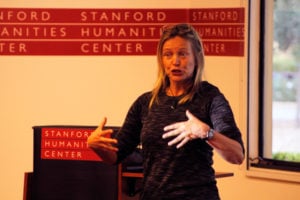
On Thursday evening, the Stanford Faculty Women’s Forum hosted a community event highlighting the findings and recommendations of the Provost’s Task Force on Women in Leadership.
The Task Force, which Provost John Etchemendy Ph.D. ’82 convened in 2014, sought to evaluate data regarding faculty gender representation as well as unquantifiable trends — for example, professors’ perception of gender-driven double standards — in an effort to promote gender-inclusive leadership on campus.
The group used five workshops and more than 50 personal interviews with male and female leaders across campus to come to its conclusions and fuel conversations on inclusive leadership. Members of the Task Force, which included representatives from all Stanford schools, also gathered available data on faculty representation by gender.
The Task Force identified three central issues important to faculty and administrators across campus. These concerns included a lack of transparency and inclusiveness in faculty, administrator and graduate student selection, as well as high opportunity costs for taking leadership positions on campus. Finally, they worried that leaders on campus aren’t held accountable enough for performance reviews and selection decisions.
The community meeting followed Gerritsen’s presentation of the results to the Faculty Senate in mid-October, after the results were released in September.
The Task Force offered 15 recommendations across five categories derived from the three central issues: reduce barriers to attaining leadership; nurture individuals with leadership potential, with particular attention to inclusiveness; strengthen processes for inclusiveness in the selection of leaders; promote the success of current leaders at all levels; and insure institutional commitment to inclusive leadership through accountability and regular reporting.
The event began with two presentations. The first, given by Margot Gerritsen, the Task Force chair and an associate professor of energy resources engineering, offered an explanation of the Task Force’s process and fifteen ultimate recommendations. The second, given by Task Force member and electrical engineering professor Andrea Goldsmith, delved into the metrics of faculty leadership’s gender inequity.
Gerritsen emphasized that many pathways to high-caliber administrative positions exist, and that faculty in lower tiers of the academic hierarchy might benefit from greater transparency on the many paths to University leadership.
Introducing a series of graphs detailing faculty composition, Goldsmith emphasized the importance of present and future metrics in the Task Force’s findings.
“You can talk about whether things are good or bad, but without data, you can’t convince people what the status is. Without data, it’s also hard to measure progress. Data tells the story,” she said during her presentation.
This data’s narrative does suggest stark gender inequity in on-campus faculty leadership — women served as 18 percent of department chairs and 16 percent of endowed chairs from 2000-2014. Goldsmith emphasized that some leadership categories, such as president and provost, encompass so few positions that the appointment of one woman in a post would drastically alter inclusivity metrics.
Following Gerritsen’s and Goldsmith’s talks, Stanford community members asked questions and suggested possible action.
“I think one of the great values that we should have for women in leadership is reaching for goals outside the University,” said Pamela Matson, Chester Naramore Dean of the School of Earth, Energy & Environmental Sciences. “Serving in professional societies or in non-governmental organizations — that’s where great learning happens in leadership. I’d like to see us encouraging and tracking the women who are doing that. It’s professionally good for them, and it reflects well on Stanford.”
After the presentation and discussion, Gerritsen reflected positively on Matson’s comments, especially in the context of five trends that the Task Force’s interviews with faculty revealed. Both male and female interviewees said that women leaders at Stanford experience lingering, unconscious gender bias, feel scrutinized more and respected less, confront a double standard, struggle with work-family conflicts more than men do and encounter in-group favoritism that prioritizes men.
“[I valued] the emphasis on outside leadership that [Matson] brought up. I thought it was so useful,” Gerritsen said. “One of the things that we found when we interviewed people is that fewer women, compared to men, self-promote.”
Gerritsen clarified that, although the Task Force’s work is over, she and her colleagues intend to continue their advocacy of gender equity in the realm of Stanford’s leadership.
“Sometimes, task forces stop when you write a report, but we want to make sure this is taken up and people do something with it, which is why we focused a report around recommendations supported by data,” Gerritsen said. “The Task Force itself is complete. But for me, and for many other members of the Task Force, we’re not done until we know that execution will take place.”
Contact Courtney Douglas at ccd4 ‘at’ stanford.edu.
